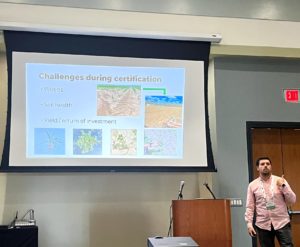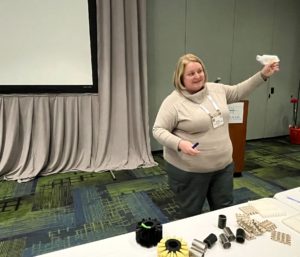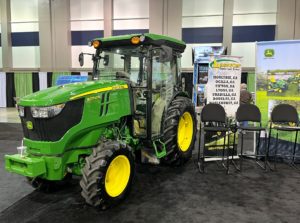Jan 11, 2023
Organic topics on agenda at Southeast Regional Fruit & Vegetable Conference
Organic farming topics played a key role in the 2023 Southeast Regional Fruit & Vegetable Conference, held Jan. 5-8 at the Savannah Convention Center in Savannah, Georgia.
Professors and assistant professors from the University of Georgia and Auburn University shared their expertise in a series of educational organic classes at the conference, which also included sessions on precision ag technology, roadside markets, food safety and various fruits and vegetables.
Andre da Silva, assistant professor of horticulture at Auburn University, is leading the transition of 24 acres to organic farming. In a 30-minute session titled “Best Management Practices for the Initial Years of Organic Transition for Vegetables,” he stressed the need to know your growing field and shared that weeds have presented the biggest challenge during the certification process.

In Alabama, commonly encountered weeds include cutleaf groundcherry, a summer weed which can grow up to 3 feet tall; Palmer amaranth, a member of the pigweed family which can climb to heights of 6 feet; and goosegrass, which can produce up to 50,000 seeds that remain viable in the soil for several years.
Da Silva and his students have also dealt with maintaining soil health and maximizing yield and return of investment.
Soil sampling is a key component in the transition, da Silva said, with findings bearing out that compaction is the main factor affecting root growth. He discussed the importance soil texture and nutrient availability, as well as cover crops, crop rotation and cultivar selection. He also detailed struggles with pests including armyworms, a familiar Southern fall predator, and aphids.
While yields of crops, including various vegetables as well as tomatoes, have initially been less than da Silva expected, he sounded an optimistic note about the process and mentioned another key factor in preserving soil health: the importance of crop termination.
“If you’re growing in the summer, don’t harvest your crop and go to the beach,” he said.
Other organic educational sessions focused on nitrogen management and cultivation and irrigation management.
Food safety sessions discussed various aspects of processing and included a primer on searching for listeria in packinghouses led by Faith Critzer, associate professor at the University of Georgia, and Laura Strawn, associate professor and Extension specialist at Virginia Tech.
In “Do I Really Want to Look for Listeria in My Packinghouse?”, the researchers stressed the importance of having a plan in place before testing for listeria — which they agreed would almost always be found if the testing is performed correctly.
“Do you want to go looking for those answers if you don’t know how to react?” Strawn said.
Intentionality of testing, standardization of process, concrete goals and a clear process of how to proceed if contamination is found are key elements to bear in mind, the researchers said before leading a hands-on swabbing demonstration.

While the testing process needs to be well-thought out, the importance of searching for listeria was made clear by presented statistics showing a 15.9% mortality rate in the 1,662 cases of listeria monocytogenes in humans in the U.S. in 2011.
The Centers for Disease Control estimates that listeriosis is the third-leading cause of death from foodborne illness, with about 260 deaths per year.
Listeria is particularly tricky to combat, the researchers emphasized, as it can grow at refrigeration temperatures and with or without oxygen.
Key areas of testing focus should include equipment, floors, walls and drains, which Strawn called “a lovefest for listeria.”
“Positives will occur in any operation, regardless of how great your food safety programs are,” read a slide in the presentation. “Don’t make your team feel as if this is a failure, but rather a good thing that you’ve stopped the issue from spreading and can now do something about it.”
Precision ag presenters included Ai-Ping Hu, principal research engineer in in the Intelligent Sustainable Technologies Division at Georgia Tech. He shared cutting-edge projects including soft robotic arms being designed to pick berries and a knife-wielding robot automating poultry deboning— a labor-intensive and dangerous position which companies often have a hard time filling.
The robot’s design was partly inspired by DaVinci’s Vitruvian man drawing, which demonstrated that human movements could be replicated and predicted, Hu said. The automated deboner can locate, for example, a chicken shoulder joint to within three millimeters.

A packed trade show floor featured the latest equipment and products from packinghouse equipment manufacturer Durand Wayland Inc., biofertilizer EnviroKure Inc., organic weed control company Flame Engineering Inc., JBT Corp., and ag tech company Syngenta, among others.
Attendees could also participate in a silent auction boasting memorabilia including a signed jersey from soon-to-be two-time national champion and Georgia quarterback Stetson Bennett IV and wrestling boots signed by ring legends Hulk Hogan and Ric Flair.









